|
By: Randy Tevepaugh, CMAA - Streetsboro High School (OH) While it may be painfully obvious that I am not a writer or professional author, I hope what is evident in this article is my passion for high school athletics and serving our school district and community. I truly love what I do every day. Complacency will lead to failure. Never acquiesce to mediocrity. I have always believed in those phrases. It doesn't matter what profession you are in; this statement applies. In today's fast paced and ever-evolving world of technology, there are plenty of opportunities to improve upon your operation as an athletic administrator. From social media outlets to electronic ticketing, these are just a few ways to improve communication with your parents and the community and provide a positive experience for your student-athletes. I have spoken with several superintendents who were former athletic administrators and they have told me that being a director of athletics is the most challenging position in education. While I believe everyone would agree, it can be the most scrutinized as well. The one variable that we control is our efforts to improve our athletics program to ensure we provide a safe, educationally sound program that gives every student an opportunity to compete and have a positive experience. The primary goal of the NIAAA Quality Program Award (QPA) is to encourage measurement, planning, and goal setting aimed at continuous improvement of local athletic programs. Most athletic administrators I know are proactive in seeking out professional development opportunities to improve their program. With the influx of new technology, it is imperative to stay up-to-date or you may miss opportunities to efficiently and effectively connect with your community. Most recently, I attended the National Athletic Directors Conference (NADC) in Denver. I was amazed at the number of athletic administrators attending from all over the country. I facilitated several Leadership Training Courses (LTC) and attended four other courses. All of them were at capacity. It was a great experience. The nexus between professional development and this article is the NIAAA's QPA. In March of 2021, while attending an awards ceremony at the Ohio High School Athletic Association office in Columbus, Ohio, I was challenged and encouraged by Glen Gillespie, Executive Director of the Ohio Interscholastic Athletic Administrators Association (OIAAA) to pursue the NIAAA Quality Program Award. By nature, I am a very competitive person. So as my wife, Denise, stood next to me while Mr. Gillespie suggested I pursue this opportunity, she and I knew it was game on. I had already completed the prerequisite LTC 799, Standards of Excellence in Interscholastic Athletic Programs. I was also familiar with the Fourteen Legal Duties related to Negligence Litigation and Standard of Care Protocols. We have a comprehensive parent/student-athlete handbook, coaches handbook and emergency action plan that covers every athletic venue in our district and cautionary statements for each of our programs. I felt that we had a solid foundation upon which to grow. So, I requested the application from the NIAAA to begin the process. Initially, when I read all the QPA requirements, I thought the material and data needed were overwhelming, maybe insurmountable. But I committed to the process, and I wasn't going to quit until it was completed. I gathered a dynamic team of four individuals that I knew would make a significant contribution to the process and had the necessary skills based on their involvement and knowledge of interscholastic athletics. Our team consisted of Courtney Ruggaber, Web-Design and Technology, Debbie Stockard, Athletic Secretary, Staci Bohannon, Athletic Trainer, and Avery VanReeth, Research and Development. Collectively, we met weekly as a team for approximately four hours after school and daily on an as-needed basis over a six-month period. We took 468 hours to complete the QPA project requirements. In addition to this team, we also relied upon the expertise of many other educators, coaches, and administrators throughout our district to assist us in gathering evidence as well as in the development of new procedures and documents that would be implemented as a result of this NIAAA program. While the athletic department originally got the ball rolling on this process, it truly took a community effort for it to be successful. Once we engaged in the journey and started reaching our benchmarks, we were even more motivated and the desire to succeed was contagious. The drive to reach national accreditation was reinforced with the completion of each assessment category. We were aware of the impact that achieving the Exemplary Athletic Department Award from the NIAAA would have on our school district and community. The benefits would resonate for years to come. In fact, we created a “We Believe” video in collaboration with our student-athletes, parents, school board members, administrators, coaches, the Mayor of Streetsboro, and the City Council President and used it as an introduction to our submission to the NIAAA. https://drive.google.com/file/d/1rM24jlTHfknARsq3P-ar9XfKh782wYzj/view?usp=sharing We began by building a web-based design model to encapsulate our data so that we could clearly articulate our creativity and innovation while also highlighting our policies and procedures. We were excited to create a streamlined, user-friendly web-based portfolio that would showcase our evidence for each assessment category and make it efficient and easy for those that were scoring our submission. Our goal was to meet the professional benchmarks and best practices from the Interscholastic Athletic Administration as well as from the NIAAA Quality Program Assessment rubric, as outlined below. Quality Program Assessment Categories:
We were able to secure a significant amount of information from our student-athlete handbook, coaches handbook, trainers handbook, and emergency action plan. I was strategic in designating program assignments within our team based on their strengths. While we collaborated on all assessment categories, each team member was assigned multiple topics that were within their professional expertise which allowed us to be consistent in our overall evaluation of data and its application. This process also allowed our team members the flexibility to be creative in applying certain criteria and data in multiple categories. There were several incidents in which a particular policy was similar to the rubric definition, but we had to make minor modifications so that we would be in compliance. It's important to remember that whenever you make revisions in your student handbook or emergency action plan it must be approved by your school board. Also, you will need photographs of your athletic facilities, weight room, field house, locker rooms, trainer's office, AEDs, and all safety related signage. As an athletic administrator, I have the privilege of serving on several local, district, and state athletic boards. I work with many extremely talented athletic administrators. One thing I can assure you of is that most of them have an excellent athletic handbook, coaches handbook, trainers handbook, and emergency action plan that would meet and/or exceed the NIAAA criteria for the QPA. I will encourage my colleagues to pursue the NIAAA accreditation, just as I was encouraged by Mr. Gillespie. Earning this accreditation requires organization, teamwork, creativity, collaboration, and motivation. It is quite the undertaking, but what is most important is that you commit to the process and build a team around you that wholeheartedly believes in the goal and will work together to help you accomplish it. As stated previously, pursuing the NIAAA Quality Program Award took months and hundreds of manpower hours to accomplish. This collaborative effort required the support of our team, our district, our community, but also, our loved ones. Once we approved the final version of our submission and sent it off to be scored, not only were we anxiously anticipating the results, but so were our colleagues and families. In fact, Courtney Ruggaber's family would call, text, and email frequently to check in on the process, knowing just how much care and dedication our team put forth to earn this national accreditation for our district. And on the day that our team found out that we had earned this prestigious national accreditation, being the first district in Ohio to do so our team and our loved ones were reveling in celebration together. Again, this is not the type of project that one must or should attempt to conquer on their own. Many hands make for light work, but it also makes the celebration of a goal accomplished that much sweeter. A special thank you to Mr. Don Bales, QPA Program Coordinator, for his professional guidance and support. Streetsboro Mayor Glenn Broska said, “It was a privilege to be part of the NIAAA project. It exemplifies the collaboration between our community and school district.” Streetsboro School Board President Brian Violi, “Our district is very proud of the accomplishment of Mr. Tevepaugh and his team. The QPA project is a great reflection on our school district and community.” |







